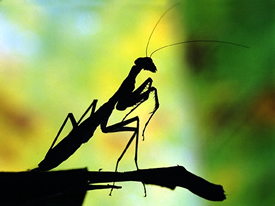Insect Carnivores
 Carnivores eat meat! Some insect carnivores catch and kill other insects (or non-insect arthropods) as food, some parasitize the bodies of other animals, and some feed by sucking blood. Zoophagy is a term for all these feeding strategies. It is derived from the Greek words “zoion” meaning animal and “phagein” the verb to eat or devour. Predators are zoophagous insects that kill Examples of
Carnivores eat meat! Some insect carnivores catch and kill other insects (or non-insect arthropods) as food, some parasitize the bodies of other animals, and some feed by sucking blood. Zoophagy is a term for all these feeding strategies. It is derived from the Greek words “zoion” meaning animal and “phagein” the verb to eat or devour. Predators are zoophagous insects that kill Examples of
Predators and eat numerous prey individuals in the course of their growth and development. They are generally larger than their prey and must often immobilize or overpower it before feeding. Some predators are generalists or opportunists: they attack a wide variety of prey species. Others are more narrow in their selection of prey. Agile, fast-moving predators (like hornets and tiger beetles) can easily overtake and subdue their prey. But other predators (like ambush bugs) blend in with their environment. They wait quietly for prey to approach and then grab it. Doodlebugs, the larval stage of ant lions, dig a shallow pit in loose sand, bury themselves at the bottom, and wait for prey to slide down into their trap. A few predators release an attractive chemical bait that lures prey within range. Predators are often regarded as useful insects when they serve as natural enemies of pest species. An Asian lady beetle, for example, may eat as many as 5000 aphids during its life cycle.
 Parasites are usually much smaller than their prey (or host) and may complete their development on the body of a single host individual. Endoparasites live inside the host’s body, whereas ectoparasites live in the host’s nest or on the surface of its body. A “true” parasite does not kill its host, but it may spread disease pathogens or cause other disability such as skin irritation, intestinal blockage, organ failure, or allergic reactions. Blood feeding (hematophagy) is a common practice among insects that parasitize vertebrate animals. Fleas (order Siphonaptera), sucking lice (order Psocodea), bed bugs and conenosed bugs (order Hemiptera), and numerous members of the order Diptera (including mosquitoes, deer flies, black flies, sand flies, and others) seek vertebrate blood meals throughout all or part of their life cycles.
Parasites are usually much smaller than their prey (or host) and may complete their development on the body of a single host individual. Endoparasites live inside the host’s body, whereas ectoparasites live in the host’s nest or on the surface of its body. A “true” parasite does not kill its host, but it may spread disease pathogens or cause other disability such as skin irritation, intestinal blockage, organ failure, or allergic reactions. Blood feeding (hematophagy) is a common practice among insects that parasitize vertebrate animals. Fleas (order Siphonaptera), sucking lice (order Psocodea), bed bugs and conenosed bugs (order Hemiptera), and numerous members of the order Diptera (including mosquitoes, deer flies, black flies, sand flies, and others) seek vertebrate blood meals throughout all or part of their life cycles.
 Many zoophagous insects live in or on the body of a single host individual during their larval stage but become free-living as adults. These insects do not fit the classical definition of a “parasite” because they feed on the internal organs and tissues of the host individual and eventually kill it. Entomologists call these insects parasitoids to distinguish them from “true” parasites such as fleas and mosquitoes. Most parasitoid species are members of the orders Diptera and Hymenoptera. Adult females use chemical cues to locate their hosts for oviposition. After hatching, young parasitoid larvae feed on non-vital tissues within the host’s body (e.g. fat body). As the larvae grow, their nutritional demands increase until they eventually consume their hosts from the inside.
Many zoophagous insects live in or on the body of a single host individual during their larval stage but become free-living as adults. These insects do not fit the classical definition of a “parasite” because they feed on the internal organs and tissues of the host individual and eventually kill it. Entomologists call these insects parasitoids to distinguish them from “true” parasites such as fleas and mosquitoes. Most parasitoid species are members of the orders Diptera and Hymenoptera. Adult females use chemical cues to locate their hosts for oviposition. After hatching, young parasitoid larvae feed on non-vital tissues within the host’s body (e.g. fat body). As the larvae grow, their nutritional demands increase until they eventually consume their hosts from the inside.
The term “parasite” also encompasses several groups of zoophagous insects that have been given special names because they have distinctive ecological characteristics:
- Hyperparasitoids are parasitoids of another parasitoid species.
- Heteronomous parasitoids are species in which the male and female larvae have different feeding habits
- Diphagous parasitoids male and female larvae feed on different parts of the same host
- Heteronomous hyperparasitoids male larvae are hyperparasitoids of female larvae
- Heterotrophic parasitoids male and female larvae develop on completely different host species
- Kleptoparasites are insects that steal food or other resources that have been collected or stored by other species.
- Brood parasites are insects that live in and co-opt workers and/or resources in the nests of social insects.

